Analyzing Global E-Government Through Enterprise Intelligence: A Case
VerifiedAdded on 2023/04/20
|11
|2905
|196
Case Study
AI Summary
This case study report elaborates on the development of an e-government system for the United Nations, focusing on the utilization of Enterprise Intelligence (EI) and the implementation of Enterprise Information Architecture (EIA). It covers the benefits of EIA in transforming traditional government services, emphasizing citizen-centric approaches, interoperability, and collaboration. The report discusses key areas such as information resources and performance risk, highlighting how EI enhances data management, risk assessment, and decision-making. It also examines the application of EIA Reference Architecture in creating an effective e-government system, including data modeling, enterprise information management, and improved decision-making processes. The report concludes with recommendations to mitigate potential risks associated with the implemented system, offering insights into the transformation of UN government services through advanced technology. Desklib provides access to similar case studies and solved assignments for students.
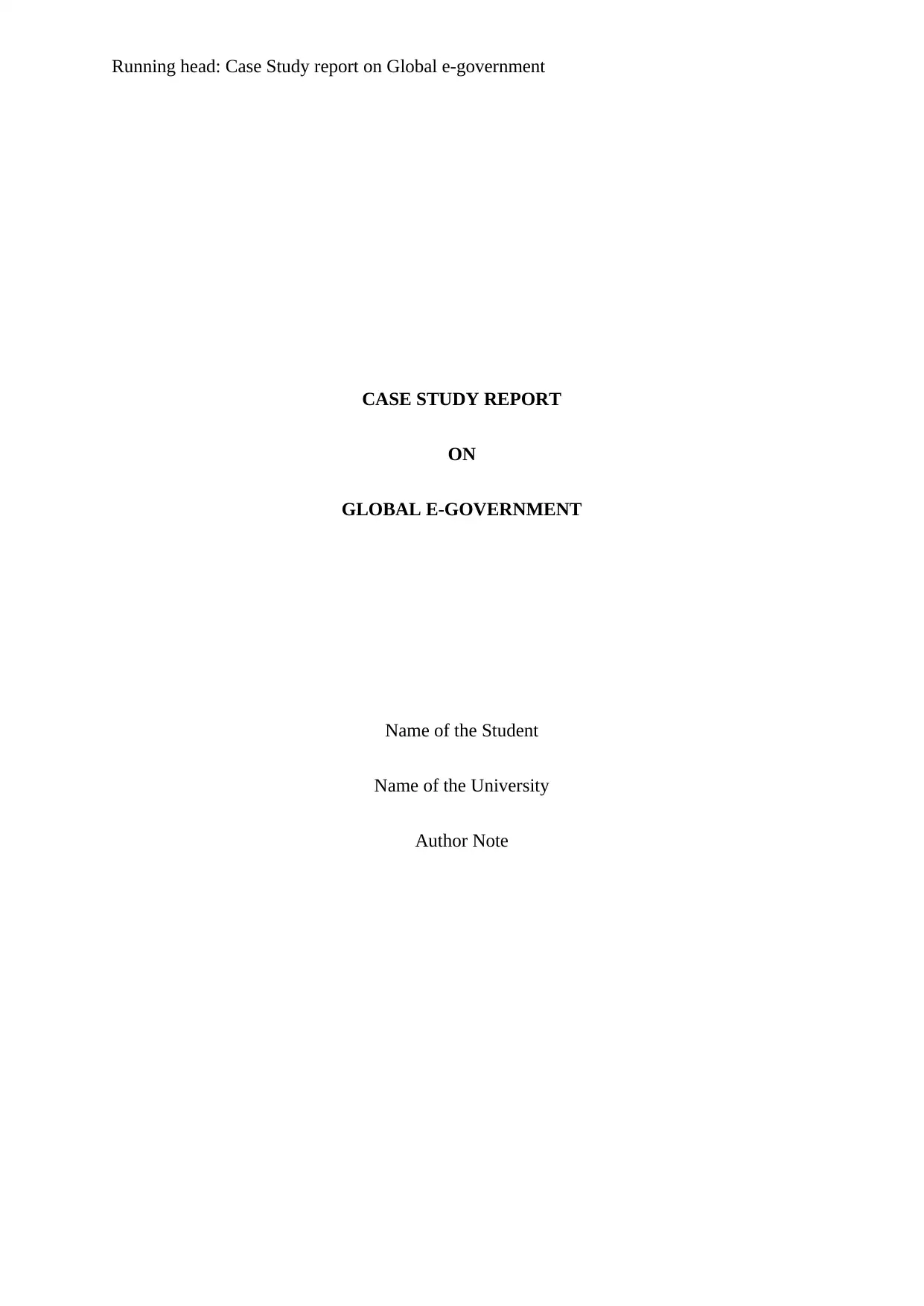
Running head: Case Study report on Global e-government
CASE STUDY REPORT
ON
GLOBAL E-GOVERNMENT
Name of the Student
Name of the University
Author Note
CASE STUDY REPORT
ON
GLOBAL E-GOVERNMENT
Name of the Student
Name of the University
Author Note
Paraphrase This Document
Need a fresh take? Get an instant paraphrase of this document with our AI Paraphraser
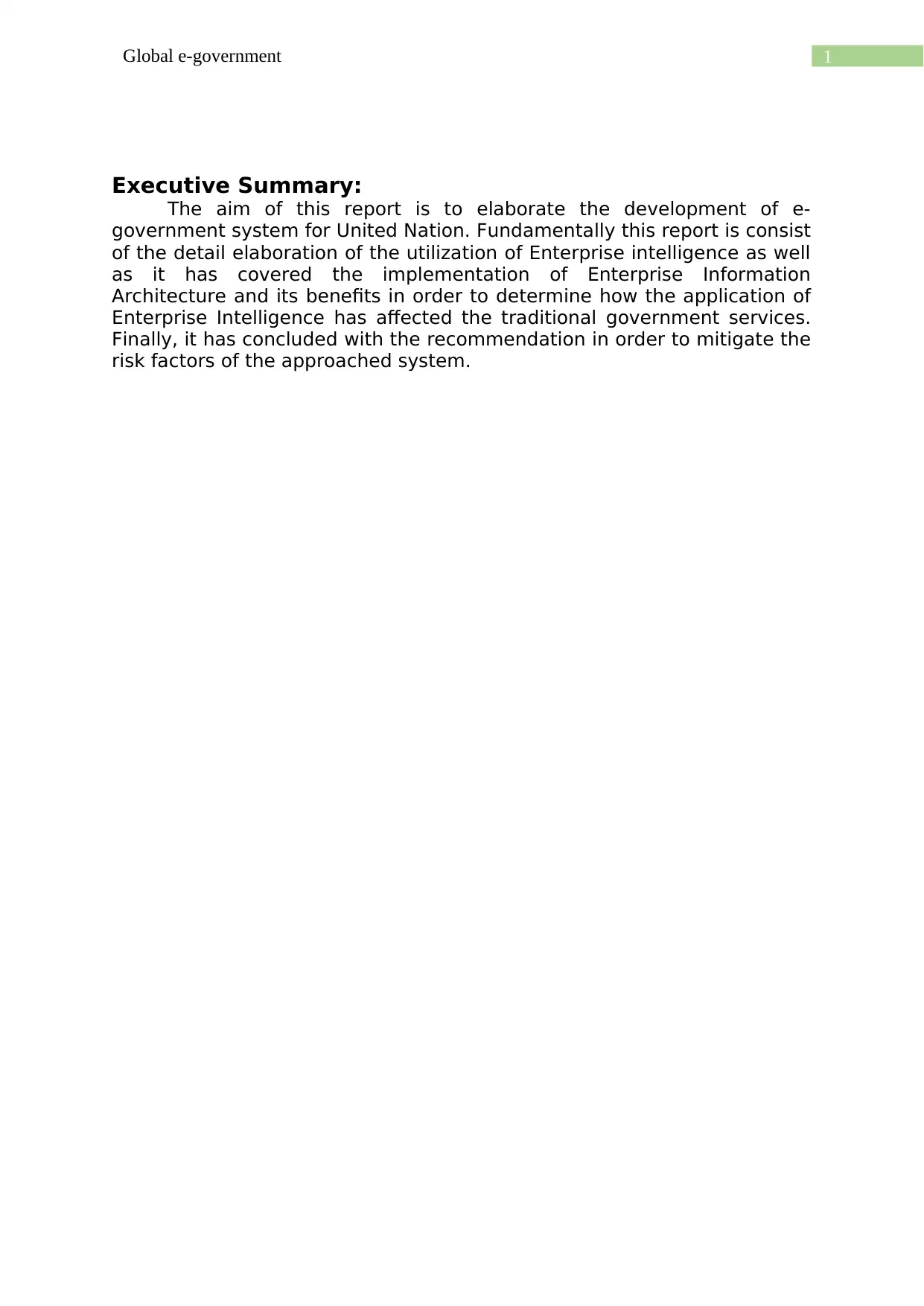
1Global e-government
Executive Summary:
The aim of this report is to elaborate the development of e-
government system for United Nation. Fundamentally this report is consist
of the detail elaboration of the utilization of Enterprise intelligence as well
as it has covered the implementation of Enterprise Information
Architecture and its benefits in order to determine how the application of
Enterprise Intelligence has affected the traditional government services.
Finally, it has concluded with the recommendation in order to mitigate the
risk factors of the approached system.
Executive Summary:
The aim of this report is to elaborate the development of e-
government system for United Nation. Fundamentally this report is consist
of the detail elaboration of the utilization of Enterprise intelligence as well
as it has covered the implementation of Enterprise Information
Architecture and its benefits in order to determine how the application of
Enterprise Intelligence has affected the traditional government services.
Finally, it has concluded with the recommendation in order to mitigate the
risk factors of the approached system.
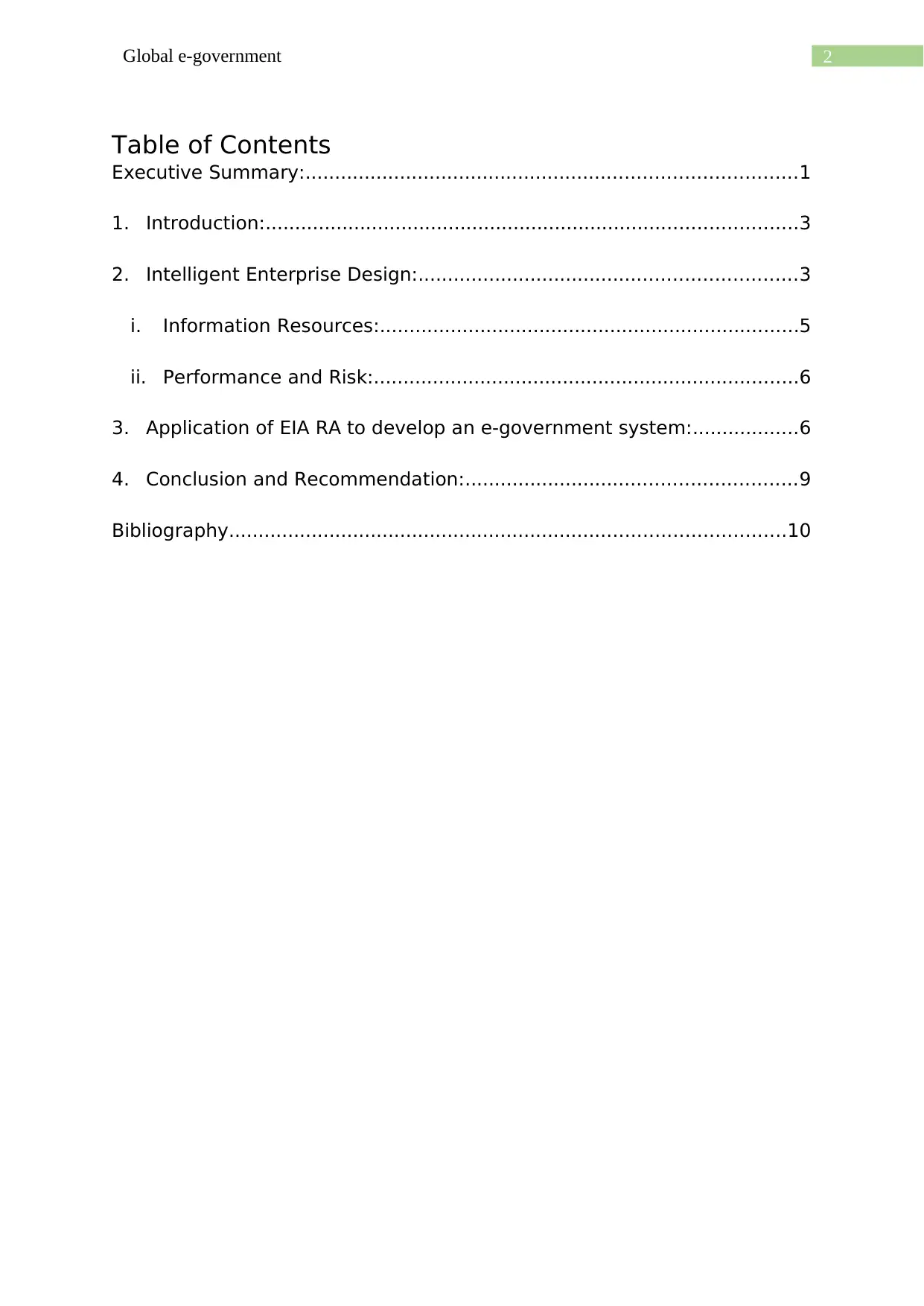
2Global e-government
Table of Contents
Executive Summary:...................................................................................1
1. Introduction:..........................................................................................3
2. Intelligent Enterprise Design:................................................................3
i. Information Resources:.......................................................................5
ii. Performance and Risk:........................................................................6
3. Application of EIA RA to develop an e-government system:..................6
4. Conclusion and Recommendation:........................................................9
Bibliography..............................................................................................10
Table of Contents
Executive Summary:...................................................................................1
1. Introduction:..........................................................................................3
2. Intelligent Enterprise Design:................................................................3
i. Information Resources:.......................................................................5
ii. Performance and Risk:........................................................................6
3. Application of EIA RA to develop an e-government system:..................6
4. Conclusion and Recommendation:........................................................9
Bibliography..............................................................................................10
⊘ This is a preview!⊘
Do you want full access?
Subscribe today to unlock all pages.

Trusted by 1+ million students worldwide
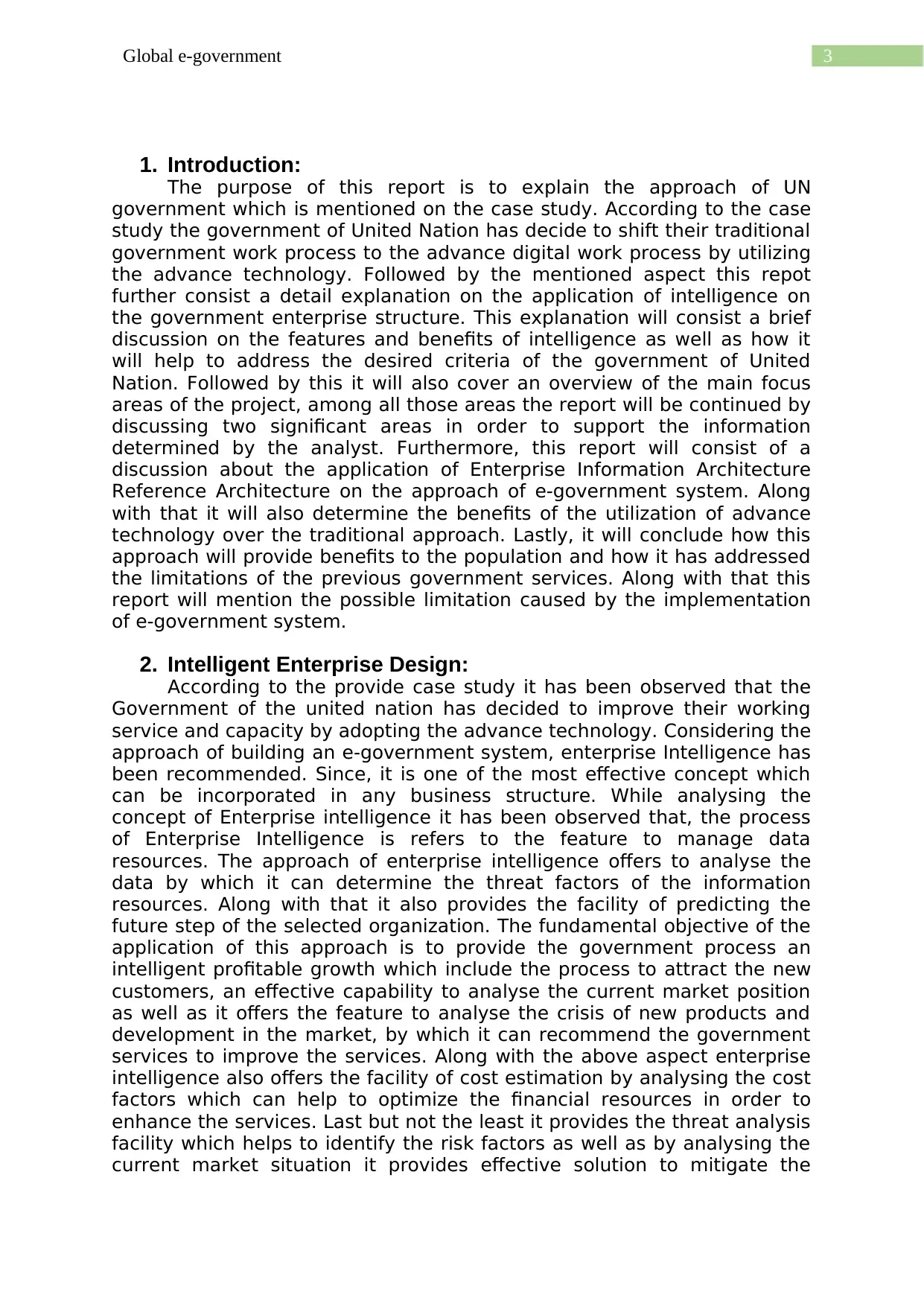
3Global e-government
1. Introduction:
The purpose of this report is to explain the approach of UN
government which is mentioned on the case study. According to the case
study the government of United Nation has decide to shift their traditional
government work process to the advance digital work process by utilizing
the advance technology. Followed by the mentioned aspect this repot
further consist a detail explanation on the application of intelligence on
the government enterprise structure. This explanation will consist a brief
discussion on the features and benefits of intelligence as well as how it
will help to address the desired criteria of the government of United
Nation. Followed by this it will also cover an overview of the main focus
areas of the project, among all those areas the report will be continued by
discussing two significant areas in order to support the information
determined by the analyst. Furthermore, this report will consist of a
discussion about the application of Enterprise Information Architecture
Reference Architecture on the approach of e-government system. Along
with that it will also determine the benefits of the utilization of advance
technology over the traditional approach. Lastly, it will conclude how this
approach will provide benefits to the population and how it has addressed
the limitations of the previous government services. Along with that this
report will mention the possible limitation caused by the implementation
of e-government system.
2. Intelligent Enterprise Design:
According to the provide case study it has been observed that the
Government of the united nation has decided to improve their working
service and capacity by adopting the advance technology. Considering the
approach of building an e-government system, enterprise Intelligence has
been recommended. Since, it is one of the most effective concept which
can be incorporated in any business structure. While analysing the
concept of Enterprise intelligence it has been observed that, the process
of Enterprise Intelligence is refers to the feature to manage data
resources. The approach of enterprise intelligence offers to analyse the
data by which it can determine the threat factors of the information
resources. Along with that it also provides the facility of predicting the
future step of the selected organization. The fundamental objective of the
application of this approach is to provide the government process an
intelligent profitable growth which include the process to attract the new
customers, an effective capability to analyse the current market position
as well as it offers the feature to analyse the crisis of new products and
development in the market, by which it can recommend the government
services to improve the services. Along with the above aspect enterprise
intelligence also offers the facility of cost estimation by analysing the cost
factors which can help to optimize the financial resources in order to
enhance the services. Last but not the least it provides the threat analysis
facility which helps to identify the risk factors as well as by analysing the
current market situation it provides effective solution to mitigate the
1. Introduction:
The purpose of this report is to explain the approach of UN
government which is mentioned on the case study. According to the case
study the government of United Nation has decide to shift their traditional
government work process to the advance digital work process by utilizing
the advance technology. Followed by the mentioned aspect this repot
further consist a detail explanation on the application of intelligence on
the government enterprise structure. This explanation will consist a brief
discussion on the features and benefits of intelligence as well as how it
will help to address the desired criteria of the government of United
Nation. Followed by this it will also cover an overview of the main focus
areas of the project, among all those areas the report will be continued by
discussing two significant areas in order to support the information
determined by the analyst. Furthermore, this report will consist of a
discussion about the application of Enterprise Information Architecture
Reference Architecture on the approach of e-government system. Along
with that it will also determine the benefits of the utilization of advance
technology over the traditional approach. Lastly, it will conclude how this
approach will provide benefits to the population and how it has addressed
the limitations of the previous government services. Along with that this
report will mention the possible limitation caused by the implementation
of e-government system.
2. Intelligent Enterprise Design:
According to the provide case study it has been observed that the
Government of the united nation has decided to improve their working
service and capacity by adopting the advance technology. Considering the
approach of building an e-government system, enterprise Intelligence has
been recommended. Since, it is one of the most effective concept which
can be incorporated in any business structure. While analysing the
concept of Enterprise intelligence it has been observed that, the process
of Enterprise Intelligence is refers to the feature to manage data
resources. The approach of enterprise intelligence offers to analyse the
data by which it can determine the threat factors of the information
resources. Along with that it also provides the facility of predicting the
future step of the selected organization. The fundamental objective of the
application of this approach is to provide the government process an
intelligent profitable growth which include the process to attract the new
customers, an effective capability to analyse the current market position
as well as it offers the feature to analyse the crisis of new products and
development in the market, by which it can recommend the government
services to improve the services. Along with the above aspect enterprise
intelligence also offers the facility of cost estimation by analysing the cost
factors which can help to optimize the financial resources in order to
enhance the services. Last but not the least it provides the threat analysis
facility which helps to identify the risk factors as well as by analysing the
current market situation it provides effective solution to mitigate the
Paraphrase This Document
Need a fresh take? Get an instant paraphrase of this document with our AI Paraphraser
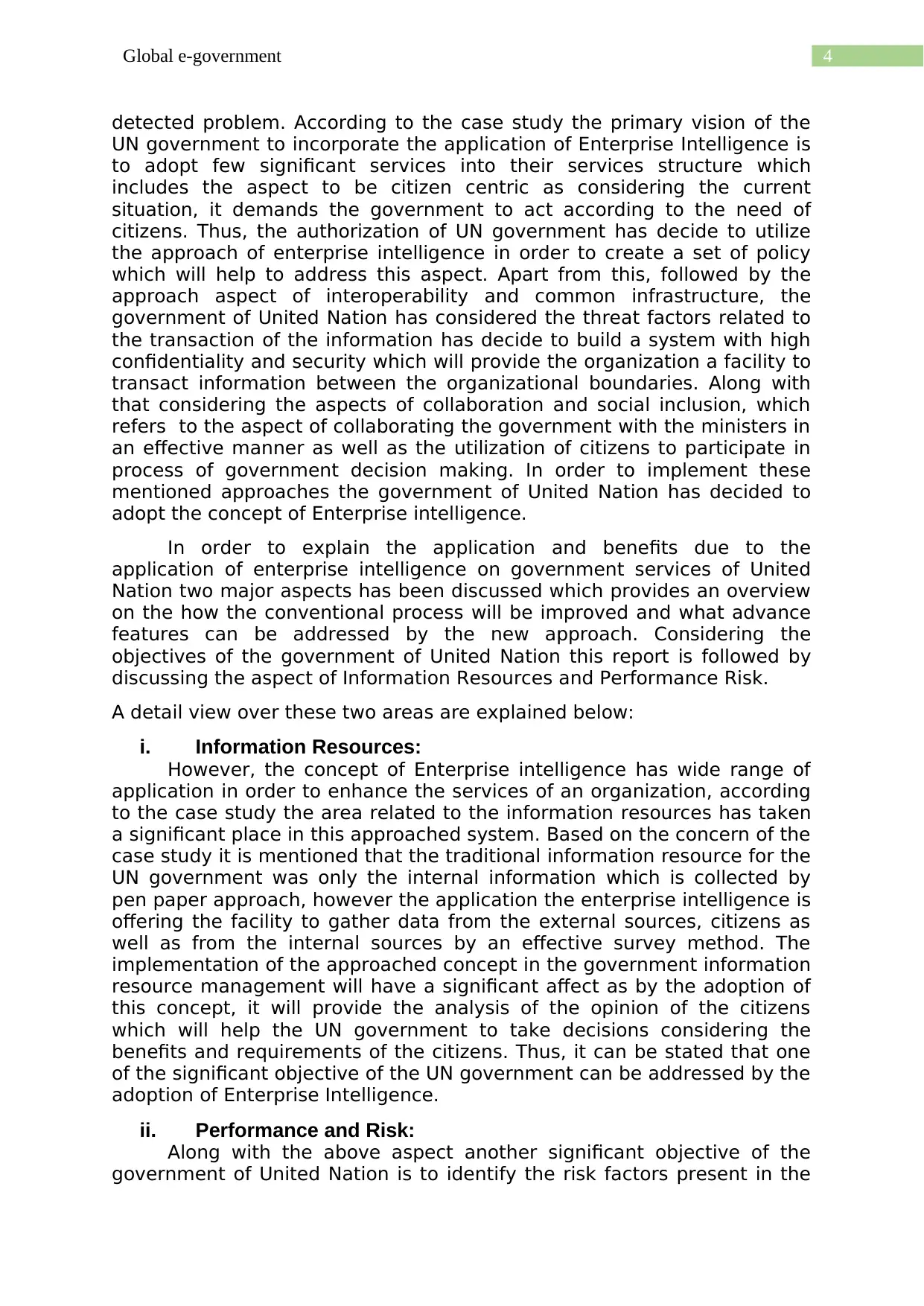
4Global e-government
detected problem. According to the case study the primary vision of the
UN government to incorporate the application of Enterprise Intelligence is
to adopt few significant services into their services structure which
includes the aspect to be citizen centric as considering the current
situation, it demands the government to act according to the need of
citizens. Thus, the authorization of UN government has decide to utilize
the approach of enterprise intelligence in order to create a set of policy
which will help to address this aspect. Apart from this, followed by the
approach aspect of interoperability and common infrastructure, the
government of United Nation has considered the threat factors related to
the transaction of the information has decide to build a system with high
confidentiality and security which will provide the organization a facility to
transact information between the organizational boundaries. Along with
that considering the aspects of collaboration and social inclusion, which
refers to the aspect of collaborating the government with the ministers in
an effective manner as well as the utilization of citizens to participate in
process of government decision making. In order to implement these
mentioned approaches the government of United Nation has decided to
adopt the concept of Enterprise intelligence.
In order to explain the application and benefits due to the
application of enterprise intelligence on government services of United
Nation two major aspects has been discussed which provides an overview
on the how the conventional process will be improved and what advance
features can be addressed by the new approach. Considering the
objectives of the government of United Nation this report is followed by
discussing the aspect of Information Resources and Performance Risk.
A detail view over these two areas are explained below:
i. Information Resources:
However, the concept of Enterprise intelligence has wide range of
application in order to enhance the services of an organization, according
to the case study the area related to the information resources has taken
a significant place in this approached system. Based on the concern of the
case study it is mentioned that the traditional information resource for the
UN government was only the internal information which is collected by
pen paper approach, however the application the enterprise intelligence is
offering the facility to gather data from the external sources, citizens as
well as from the internal sources by an effective survey method. The
implementation of the approached concept in the government information
resource management will have a significant affect as by the adoption of
this concept, it will provide the analysis of the opinion of the citizens
which will help the UN government to take decisions considering the
benefits and requirements of the citizens. Thus, it can be stated that one
of the significant objective of the UN government can be addressed by the
adoption of Enterprise Intelligence.
ii. Performance and Risk:
Along with the above aspect another significant objective of the
government of United Nation is to identify the risk factors present in the
detected problem. According to the case study the primary vision of the
UN government to incorporate the application of Enterprise Intelligence is
to adopt few significant services into their services structure which
includes the aspect to be citizen centric as considering the current
situation, it demands the government to act according to the need of
citizens. Thus, the authorization of UN government has decide to utilize
the approach of enterprise intelligence in order to create a set of policy
which will help to address this aspect. Apart from this, followed by the
approach aspect of interoperability and common infrastructure, the
government of United Nation has considered the threat factors related to
the transaction of the information has decide to build a system with high
confidentiality and security which will provide the organization a facility to
transact information between the organizational boundaries. Along with
that considering the aspects of collaboration and social inclusion, which
refers to the aspect of collaborating the government with the ministers in
an effective manner as well as the utilization of citizens to participate in
process of government decision making. In order to implement these
mentioned approaches the government of United Nation has decided to
adopt the concept of Enterprise intelligence.
In order to explain the application and benefits due to the
application of enterprise intelligence on government services of United
Nation two major aspects has been discussed which provides an overview
on the how the conventional process will be improved and what advance
features can be addressed by the new approach. Considering the
objectives of the government of United Nation this report is followed by
discussing the aspect of Information Resources and Performance Risk.
A detail view over these two areas are explained below:
i. Information Resources:
However, the concept of Enterprise intelligence has wide range of
application in order to enhance the services of an organization, according
to the case study the area related to the information resources has taken
a significant place in this approached system. Based on the concern of the
case study it is mentioned that the traditional information resource for the
UN government was only the internal information which is collected by
pen paper approach, however the application the enterprise intelligence is
offering the facility to gather data from the external sources, citizens as
well as from the internal sources by an effective survey method. The
implementation of the approached concept in the government information
resource management will have a significant affect as by the adoption of
this concept, it will provide the analysis of the opinion of the citizens
which will help the UN government to take decisions considering the
benefits and requirements of the citizens. Thus, it can be stated that one
of the significant objective of the UN government can be addressed by the
adoption of Enterprise Intelligence.
ii. Performance and Risk:
Along with the above aspect another significant objective of the
government of United Nation is to identify the risk factors present in the
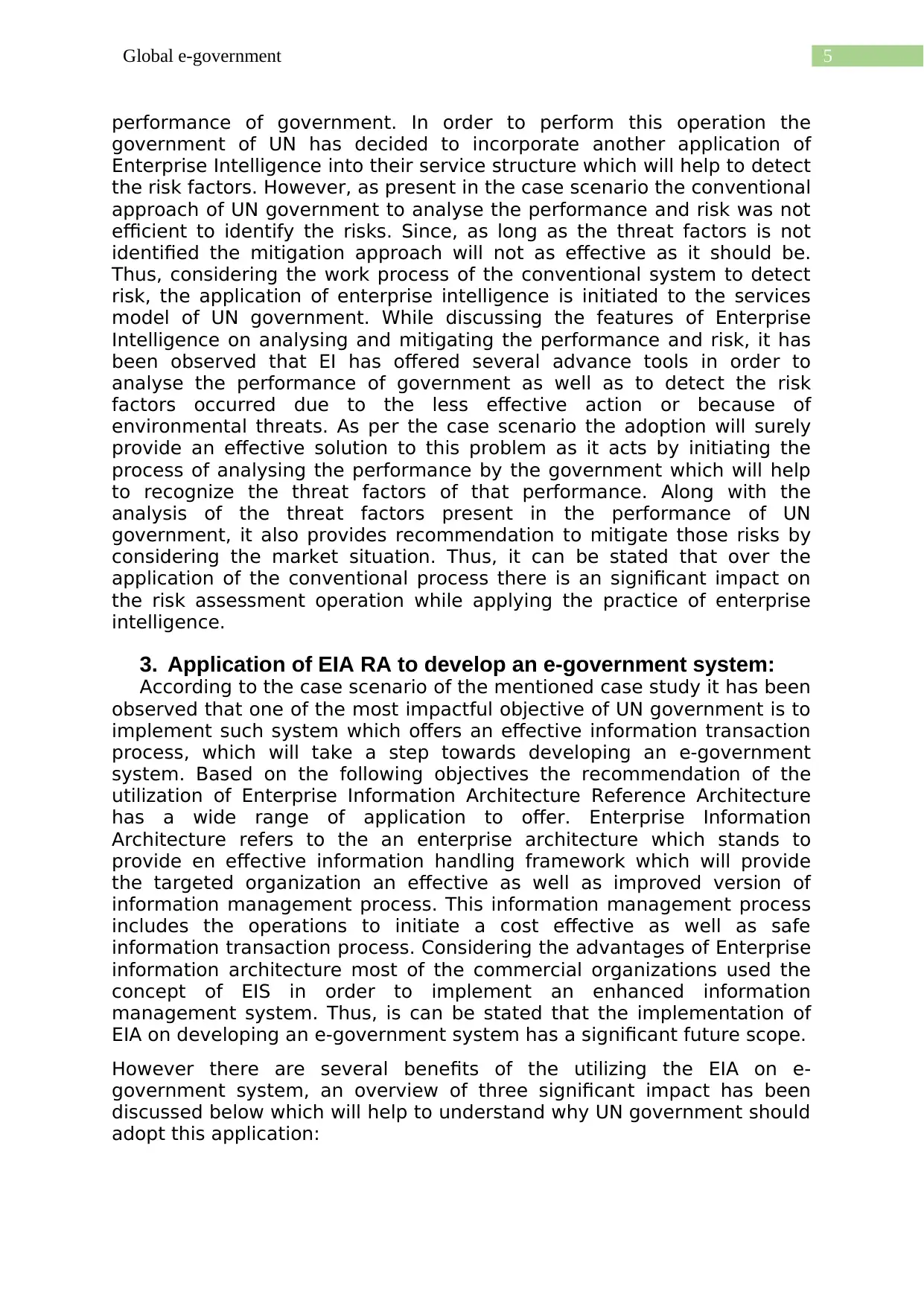
5Global e-government
performance of government. In order to perform this operation the
government of UN has decided to incorporate another application of
Enterprise Intelligence into their service structure which will help to detect
the risk factors. However, as present in the case scenario the conventional
approach of UN government to analyse the performance and risk was not
efficient to identify the risks. Since, as long as the threat factors is not
identified the mitigation approach will not as effective as it should be.
Thus, considering the work process of the conventional system to detect
risk, the application of enterprise intelligence is initiated to the services
model of UN government. While discussing the features of Enterprise
Intelligence on analysing and mitigating the performance and risk, it has
been observed that EI has offered several advance tools in order to
analyse the performance of government as well as to detect the risk
factors occurred due to the less effective action or because of
environmental threats. As per the case scenario the adoption will surely
provide an effective solution to this problem as it acts by initiating the
process of analysing the performance by the government which will help
to recognize the threat factors of that performance. Along with the
analysis of the threat factors present in the performance of UN
government, it also provides recommendation to mitigate those risks by
considering the market situation. Thus, it can be stated that over the
application of the conventional process there is an significant impact on
the risk assessment operation while applying the practice of enterprise
intelligence.
3. Application of EIA RA to develop an e-government system:
According to the case scenario of the mentioned case study it has been
observed that one of the most impactful objective of UN government is to
implement such system which offers an effective information transaction
process, which will take a step towards developing an e-government
system. Based on the following objectives the recommendation of the
utilization of Enterprise Information Architecture Reference Architecture
has a wide range of application to offer. Enterprise Information
Architecture refers to the an enterprise architecture which stands to
provide en effective information handling framework which will provide
the targeted organization an effective as well as improved version of
information management process. This information management process
includes the operations to initiate a cost effective as well as safe
information transaction process. Considering the advantages of Enterprise
information architecture most of the commercial organizations used the
concept of EIS in order to implement an enhanced information
management system. Thus, is can be stated that the implementation of
EIA on developing an e-government system has a significant future scope.
However there are several benefits of the utilizing the EIA on e-
government system, an overview of three significant impact has been
discussed below which will help to understand why UN government should
adopt this application:
performance of government. In order to perform this operation the
government of UN has decided to incorporate another application of
Enterprise Intelligence into their service structure which will help to detect
the risk factors. However, as present in the case scenario the conventional
approach of UN government to analyse the performance and risk was not
efficient to identify the risks. Since, as long as the threat factors is not
identified the mitigation approach will not as effective as it should be.
Thus, considering the work process of the conventional system to detect
risk, the application of enterprise intelligence is initiated to the services
model of UN government. While discussing the features of Enterprise
Intelligence on analysing and mitigating the performance and risk, it has
been observed that EI has offered several advance tools in order to
analyse the performance of government as well as to detect the risk
factors occurred due to the less effective action or because of
environmental threats. As per the case scenario the adoption will surely
provide an effective solution to this problem as it acts by initiating the
process of analysing the performance by the government which will help
to recognize the threat factors of that performance. Along with the
analysis of the threat factors present in the performance of UN
government, it also provides recommendation to mitigate those risks by
considering the market situation. Thus, it can be stated that over the
application of the conventional process there is an significant impact on
the risk assessment operation while applying the practice of enterprise
intelligence.
3. Application of EIA RA to develop an e-government system:
According to the case scenario of the mentioned case study it has been
observed that one of the most impactful objective of UN government is to
implement such system which offers an effective information transaction
process, which will take a step towards developing an e-government
system. Based on the following objectives the recommendation of the
utilization of Enterprise Information Architecture Reference Architecture
has a wide range of application to offer. Enterprise Information
Architecture refers to the an enterprise architecture which stands to
provide en effective information handling framework which will provide
the targeted organization an effective as well as improved version of
information management process. This information management process
includes the operations to initiate a cost effective as well as safe
information transaction process. Considering the advantages of Enterprise
information architecture most of the commercial organizations used the
concept of EIS in order to implement an enhanced information
management system. Thus, is can be stated that the implementation of
EIA on developing an e-government system has a significant future scope.
However there are several benefits of the utilizing the EIA on e-
government system, an overview of three significant impact has been
discussed below which will help to understand why UN government should
adopt this application:
⊘ This is a preview!⊘
Do you want full access?
Subscribe today to unlock all pages.

Trusted by 1+ million students worldwide
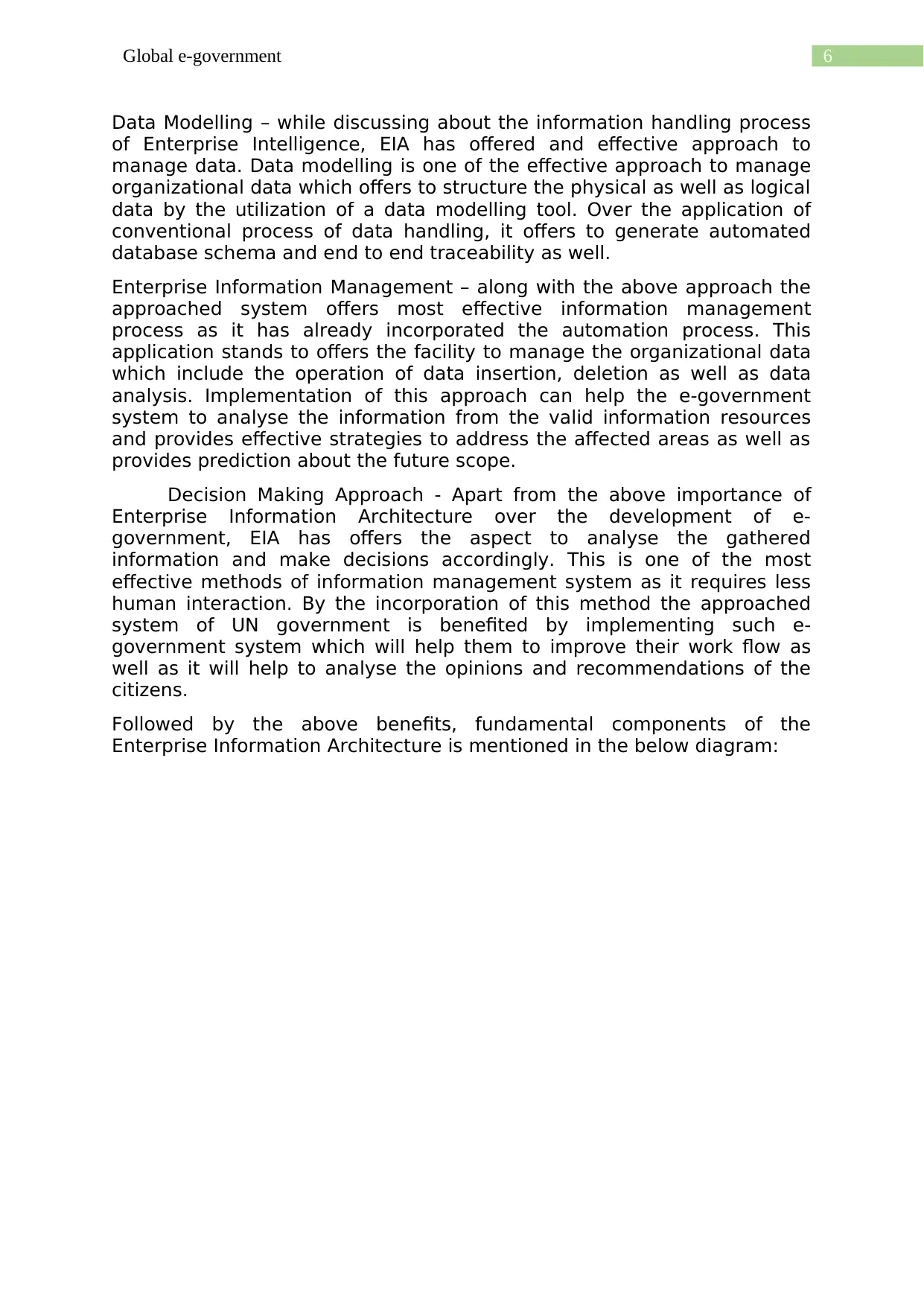
6Global e-government
Data Modelling – while discussing about the information handling process
of Enterprise Intelligence, EIA has offered and effective approach to
manage data. Data modelling is one of the effective approach to manage
organizational data which offers to structure the physical as well as logical
data by the utilization of a data modelling tool. Over the application of
conventional process of data handling, it offers to generate automated
database schema and end to end traceability as well.
Enterprise Information Management – along with the above approach the
approached system offers most effective information management
process as it has already incorporated the automation process. This
application stands to offers the facility to manage the organizational data
which include the operation of data insertion, deletion as well as data
analysis. Implementation of this approach can help the e-government
system to analyse the information from the valid information resources
and provides effective strategies to address the affected areas as well as
provides prediction about the future scope.
Decision Making Approach - Apart from the above importance of
Enterprise Information Architecture over the development of e-
government, EIA has offers the aspect to analyse the gathered
information and make decisions accordingly. This is one of the most
effective methods of information management system as it requires less
human interaction. By the incorporation of this method the approached
system of UN government is benefited by implementing such e-
government system which will help them to improve their work flow as
well as it will help to analyse the opinions and recommendations of the
citizens.
Followed by the above benefits, fundamental components of the
Enterprise Information Architecture is mentioned in the below diagram:
Data Modelling – while discussing about the information handling process
of Enterprise Intelligence, EIA has offered and effective approach to
manage data. Data modelling is one of the effective approach to manage
organizational data which offers to structure the physical as well as logical
data by the utilization of a data modelling tool. Over the application of
conventional process of data handling, it offers to generate automated
database schema and end to end traceability as well.
Enterprise Information Management – along with the above approach the
approached system offers most effective information management
process as it has already incorporated the automation process. This
application stands to offers the facility to manage the organizational data
which include the operation of data insertion, deletion as well as data
analysis. Implementation of this approach can help the e-government
system to analyse the information from the valid information resources
and provides effective strategies to address the affected areas as well as
provides prediction about the future scope.
Decision Making Approach - Apart from the above importance of
Enterprise Information Architecture over the development of e-
government, EIA has offers the aspect to analyse the gathered
information and make decisions accordingly. This is one of the most
effective methods of information management system as it requires less
human interaction. By the incorporation of this method the approached
system of UN government is benefited by implementing such e-
government system which will help them to improve their work flow as
well as it will help to analyse the opinions and recommendations of the
citizens.
Followed by the above benefits, fundamental components of the
Enterprise Information Architecture is mentioned in the below diagram:
Paraphrase This Document
Need a fresh take? Get an instant paraphrase of this document with our AI Paraphraser
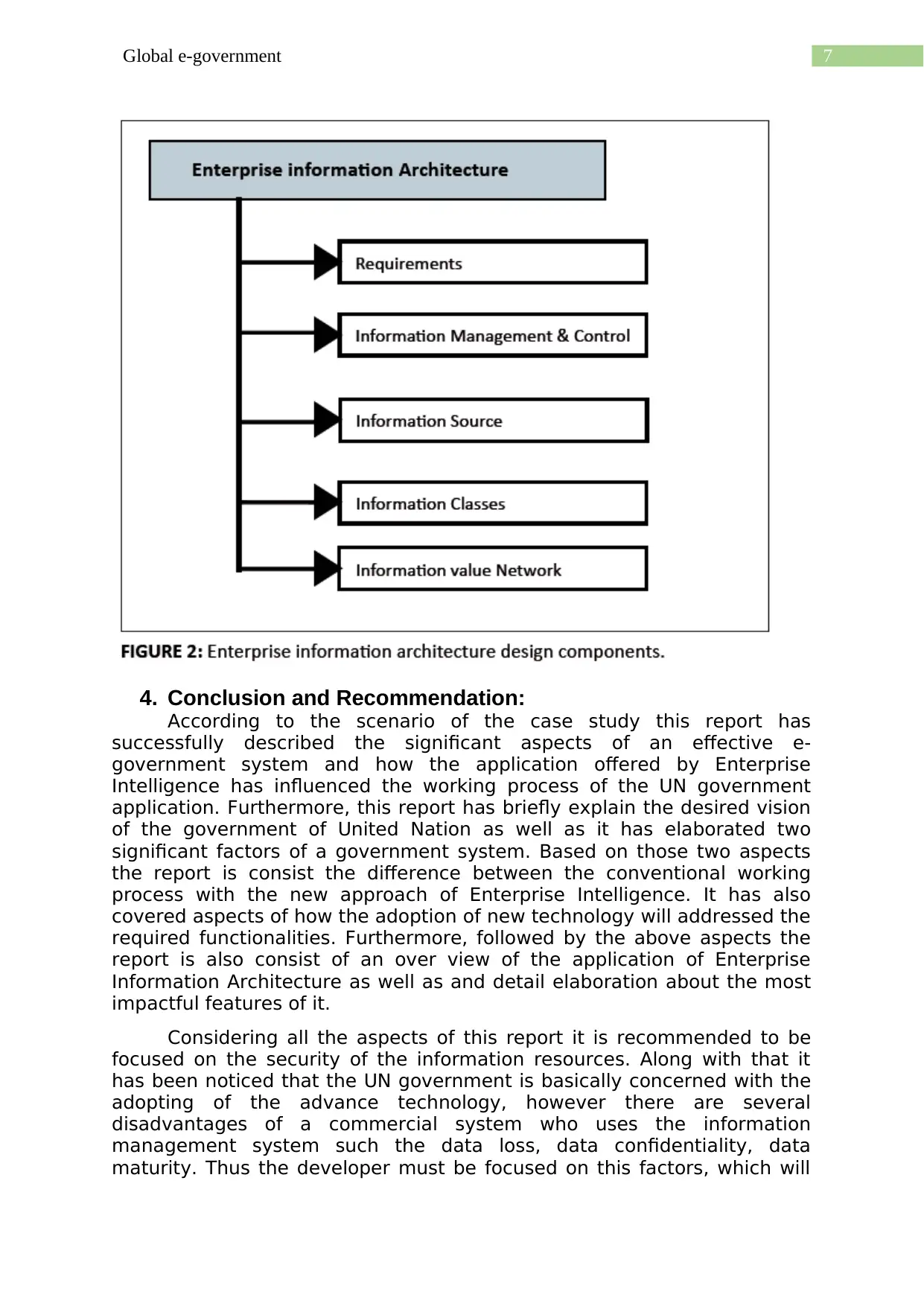
7Global e-government
4. Conclusion and Recommendation:
According to the scenario of the case study this report has
successfully described the significant aspects of an effective e-
government system and how the application offered by Enterprise
Intelligence has influenced the working process of the UN government
application. Furthermore, this report has briefly explain the desired vision
of the government of United Nation as well as it has elaborated two
significant factors of a government system. Based on those two aspects
the report is consist the difference between the conventional working
process with the new approach of Enterprise Intelligence. It has also
covered aspects of how the adoption of new technology will addressed the
required functionalities. Furthermore, followed by the above aspects the
report is also consist of an over view of the application of Enterprise
Information Architecture as well as and detail elaboration about the most
impactful features of it.
Considering all the aspects of this report it is recommended to be
focused on the security of the information resources. Along with that it
has been noticed that the UN government is basically concerned with the
adopting of the advance technology, however there are several
disadvantages of a commercial system who uses the information
management system such the data loss, data confidentiality, data
maturity. Thus the developer must be focused on this factors, which will
4. Conclusion and Recommendation:
According to the scenario of the case study this report has
successfully described the significant aspects of an effective e-
government system and how the application offered by Enterprise
Intelligence has influenced the working process of the UN government
application. Furthermore, this report has briefly explain the desired vision
of the government of United Nation as well as it has elaborated two
significant factors of a government system. Based on those two aspects
the report is consist the difference between the conventional working
process with the new approach of Enterprise Intelligence. It has also
covered aspects of how the adoption of new technology will addressed the
required functionalities. Furthermore, followed by the above aspects the
report is also consist of an over view of the application of Enterprise
Information Architecture as well as and detail elaboration about the most
impactful features of it.
Considering all the aspects of this report it is recommended to be
focused on the security of the information resources. Along with that it
has been noticed that the UN government is basically concerned with the
adopting of the advance technology, however there are several
disadvantages of a commercial system who uses the information
management system such the data loss, data confidentiality, data
maturity. Thus the developer must be focused on this factors, which will
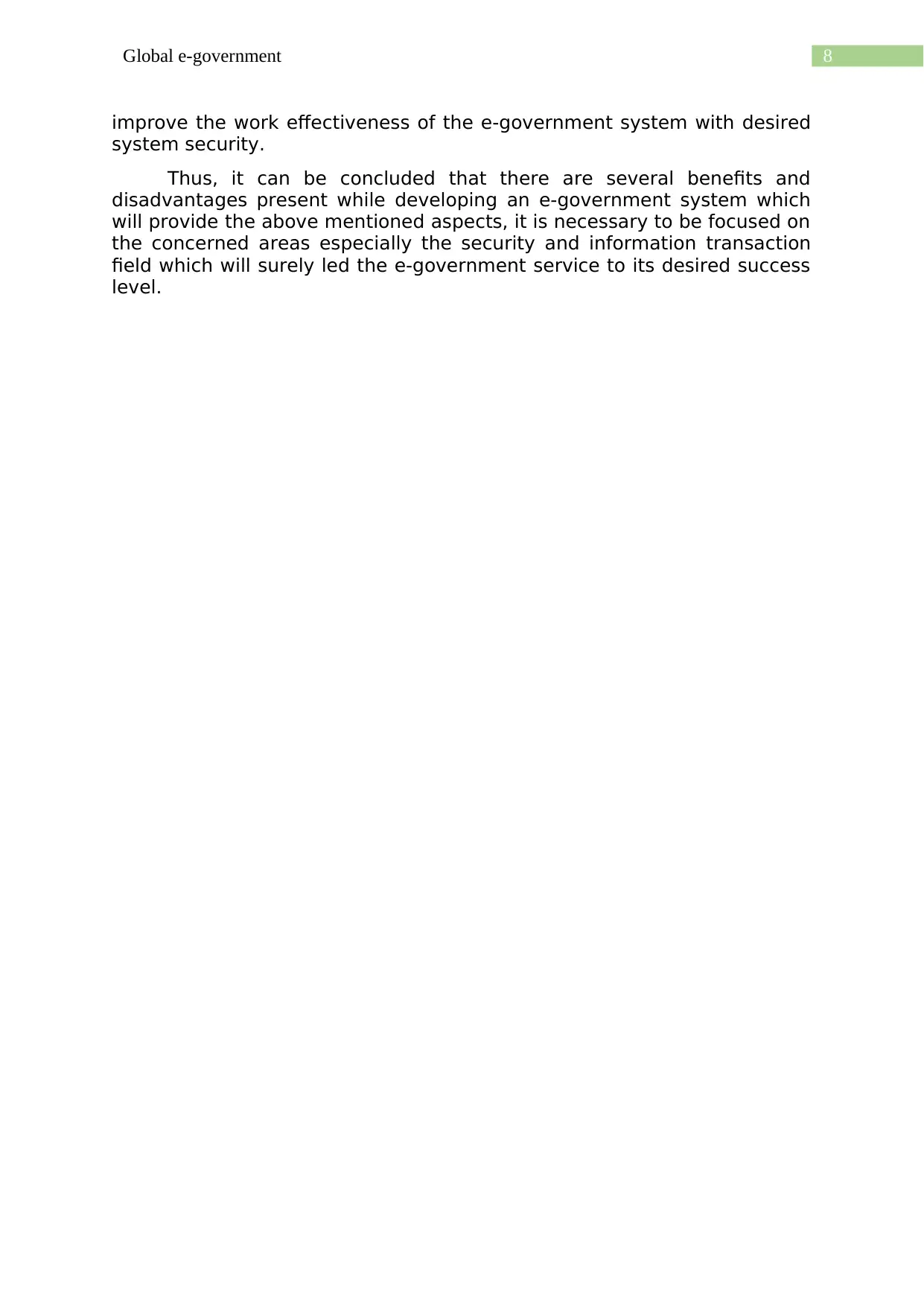
8Global e-government
improve the work effectiveness of the e-government system with desired
system security.
Thus, it can be concluded that there are several benefits and
disadvantages present while developing an e-government system which
will provide the above mentioned aspects, it is necessary to be focused on
the concerned areas especially the security and information transaction
field which will surely led the e-government service to its desired success
level.
improve the work effectiveness of the e-government system with desired
system security.
Thus, it can be concluded that there are several benefits and
disadvantages present while developing an e-government system which
will provide the above mentioned aspects, it is necessary to be focused on
the concerned areas especially the security and information transaction
field which will surely led the e-government service to its desired success
level.
⊘ This is a preview!⊘
Do you want full access?
Subscribe today to unlock all pages.

Trusted by 1+ million students worldwide
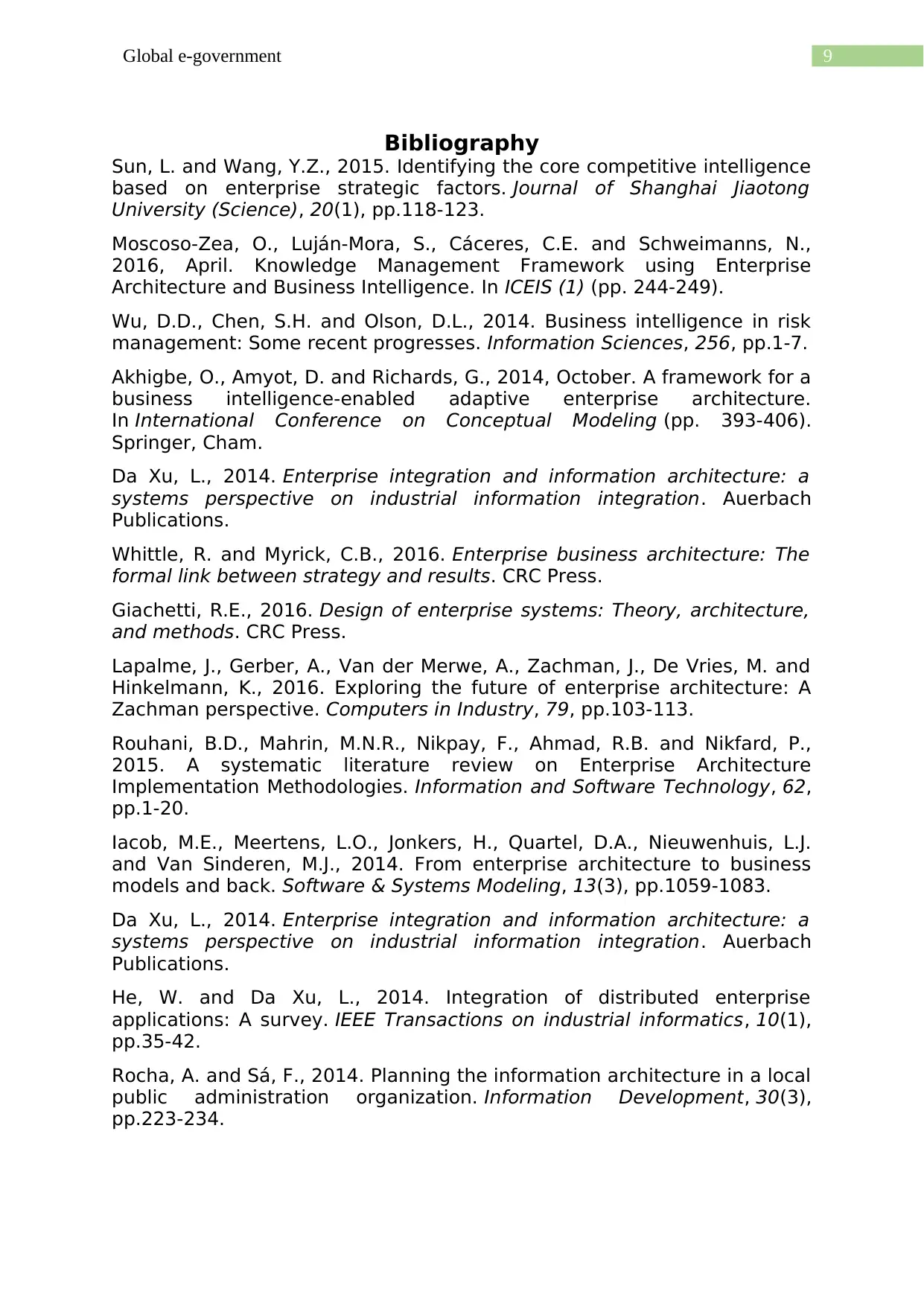
9Global e-government
Bibliography
Sun, L. and Wang, Y.Z., 2015. Identifying the core competitive intelligence
based on enterprise strategic factors. Journal of Shanghai Jiaotong
University (Science), 20(1), pp.118-123.
Moscoso-Zea, O., Luján-Mora, S., Cáceres, C.E. and Schweimanns, N.,
2016, April. Knowledge Management Framework using Enterprise
Architecture and Business Intelligence. In ICEIS (1) (pp. 244-249).
Wu, D.D., Chen, S.H. and Olson, D.L., 2014. Business intelligence in risk
management: Some recent progresses. Information Sciences, 256, pp.1-7.
Akhigbe, O., Amyot, D. and Richards, G., 2014, October. A framework for a
business intelligence-enabled adaptive enterprise architecture.
In International Conference on Conceptual Modeling (pp. 393-406).
Springer, Cham.
Da Xu, L., 2014. Enterprise integration and information architecture: a
systems perspective on industrial information integration. Auerbach
Publications.
Whittle, R. and Myrick, C.B., 2016. Enterprise business architecture: The
formal link between strategy and results. CRC Press.
Giachetti, R.E., 2016. Design of enterprise systems: Theory, architecture,
and methods. CRC Press.
Lapalme, J., Gerber, A., Van der Merwe, A., Zachman, J., De Vries, M. and
Hinkelmann, K., 2016. Exploring the future of enterprise architecture: A
Zachman perspective. Computers in Industry, 79, pp.103-113.
Rouhani, B.D., Mahrin, M.N.R., Nikpay, F., Ahmad, R.B. and Nikfard, P.,
2015. A systematic literature review on Enterprise Architecture
Implementation Methodologies. Information and Software Technology, 62,
pp.1-20.
Iacob, M.E., Meertens, L.O., Jonkers, H., Quartel, D.A., Nieuwenhuis, L.J.
and Van Sinderen, M.J., 2014. From enterprise architecture to business
models and back. Software & Systems Modeling, 13(3), pp.1059-1083.
Da Xu, L., 2014. Enterprise integration and information architecture: a
systems perspective on industrial information integration. Auerbach
Publications.
He, W. and Da Xu, L., 2014. Integration of distributed enterprise
applications: A survey. IEEE Transactions on industrial informatics, 10(1),
pp.35-42.
Rocha, A. and Sá, F., 2014. Planning the information architecture in a local
public administration organization. Information Development, 30(3),
pp.223-234.
Bibliography
Sun, L. and Wang, Y.Z., 2015. Identifying the core competitive intelligence
based on enterprise strategic factors. Journal of Shanghai Jiaotong
University (Science), 20(1), pp.118-123.
Moscoso-Zea, O., Luján-Mora, S., Cáceres, C.E. and Schweimanns, N.,
2016, April. Knowledge Management Framework using Enterprise
Architecture and Business Intelligence. In ICEIS (1) (pp. 244-249).
Wu, D.D., Chen, S.H. and Olson, D.L., 2014. Business intelligence in risk
management: Some recent progresses. Information Sciences, 256, pp.1-7.
Akhigbe, O., Amyot, D. and Richards, G., 2014, October. A framework for a
business intelligence-enabled adaptive enterprise architecture.
In International Conference on Conceptual Modeling (pp. 393-406).
Springer, Cham.
Da Xu, L., 2014. Enterprise integration and information architecture: a
systems perspective on industrial information integration. Auerbach
Publications.
Whittle, R. and Myrick, C.B., 2016. Enterprise business architecture: The
formal link between strategy and results. CRC Press.
Giachetti, R.E., 2016. Design of enterprise systems: Theory, architecture,
and methods. CRC Press.
Lapalme, J., Gerber, A., Van der Merwe, A., Zachman, J., De Vries, M. and
Hinkelmann, K., 2016. Exploring the future of enterprise architecture: A
Zachman perspective. Computers in Industry, 79, pp.103-113.
Rouhani, B.D., Mahrin, M.N.R., Nikpay, F., Ahmad, R.B. and Nikfard, P.,
2015. A systematic literature review on Enterprise Architecture
Implementation Methodologies. Information and Software Technology, 62,
pp.1-20.
Iacob, M.E., Meertens, L.O., Jonkers, H., Quartel, D.A., Nieuwenhuis, L.J.
and Van Sinderen, M.J., 2014. From enterprise architecture to business
models and back. Software & Systems Modeling, 13(3), pp.1059-1083.
Da Xu, L., 2014. Enterprise integration and information architecture: a
systems perspective on industrial information integration. Auerbach
Publications.
He, W. and Da Xu, L., 2014. Integration of distributed enterprise
applications: A survey. IEEE Transactions on industrial informatics, 10(1),
pp.35-42.
Rocha, A. and Sá, F., 2014. Planning the information architecture in a local
public administration organization. Information Development, 30(3),
pp.223-234.
Paraphrase This Document
Need a fresh take? Get an instant paraphrase of this document with our AI Paraphraser
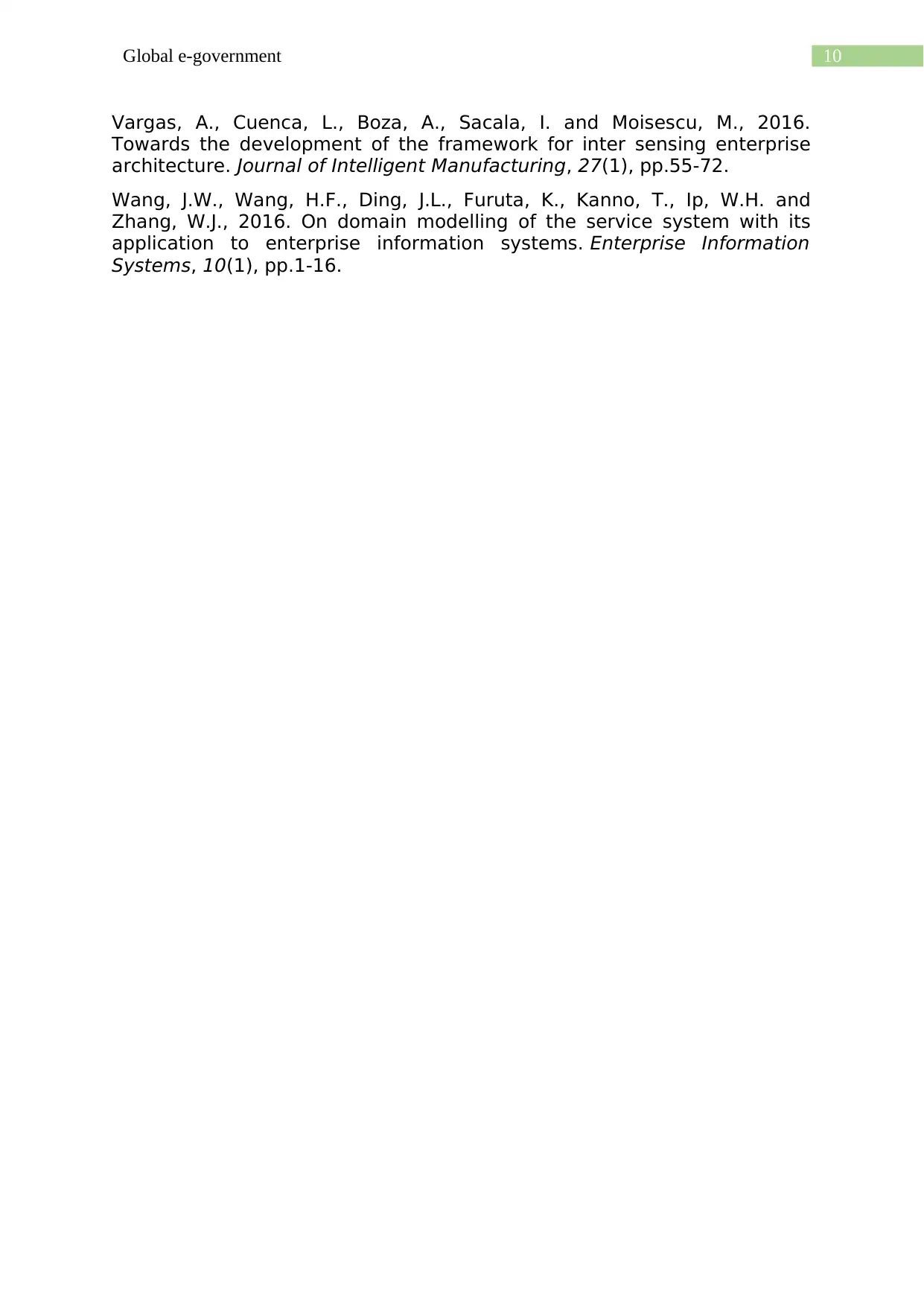
10Global e-government
Vargas, A., Cuenca, L., Boza, A., Sacala, I. and Moisescu, M., 2016.
Towards the development of the framework for inter sensing enterprise
architecture. Journal of Intelligent Manufacturing, 27(1), pp.55-72.
Wang, J.W., Wang, H.F., Ding, J.L., Furuta, K., Kanno, T., Ip, W.H. and
Zhang, W.J., 2016. On domain modelling of the service system with its
application to enterprise information systems. Enterprise Information
Systems, 10(1), pp.1-16.
Vargas, A., Cuenca, L., Boza, A., Sacala, I. and Moisescu, M., 2016.
Towards the development of the framework for inter sensing enterprise
architecture. Journal of Intelligent Manufacturing, 27(1), pp.55-72.
Wang, J.W., Wang, H.F., Ding, J.L., Furuta, K., Kanno, T., Ip, W.H. and
Zhang, W.J., 2016. On domain modelling of the service system with its
application to enterprise information systems. Enterprise Information
Systems, 10(1), pp.1-16.
1 out of 11
Related Documents
Your All-in-One AI-Powered Toolkit for Academic Success.
+13062052269
info@desklib.com
Available 24*7 on WhatsApp / Email
![[object Object]](/_next/static/media/star-bottom.7253800d.svg)
Unlock your academic potential
Copyright © 2020–2025 A2Z Services. All Rights Reserved. Developed and managed by ZUCOL.





